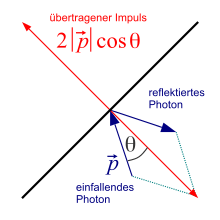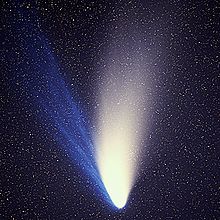Radiation pressure
Radiation pressure 
For absorption and emission, the radiation pressure is equal to the intensity 


with the units
![{\displaystyle \left[p_{\mathrm {St} }\right]={\frac {\mathrm {N} }{\mathrm {m} ^{2}}}={\frac {\mathrm {Nm} }{\mathrm {m} ^{3}}}={\frac {\mathrm {J} }{\mathrm {m} ^{3}}}=\mathrm {Pa} }](https://www.alegsaonline.com/image/bf394cd4a78f7c48f68d7a65d82920d6dc9cc64f.svg)
with complete reflection, the radiation pressure is twice as large as with complete absorption.
History and proof
That light exerts a pressure was postulated by Johannes Kepler as an explanation for comet tails always directed away from the sun. James Clerk Maxwell derived in 1873 from Maxwell's equations within the framework of electrodynamics that electromagnetic waves can exert a pressure on bodies. He already showed that the radiation pressure of vertically incident electromagnetic waves is equal to the volumetric energy density 
In 1876, Adolfo Bartoli derived the existence of radiation pressure from thermodynamic considerations. He argued that by reflection of the light at a moving mirror, heat could be transferred from a cold to the hot body due to the Doppler effect. To avoid this violation of the second law of thermodynamics, it is necessary that the light exerts a pressure on the mirror. Therefore, the radiation pressure used to be called Maxwell-Bartolian pressure after its discoverers.
The first experimental confirmations came from Pyotr Nikolaevich Lebedev (1901) and from Ernest Fox Nichols and Gordon Ferrie Hull (1903). In 1972, the physicist Arthur Ashkin irradiated small plastic beads with laser light and was able to observe a change in motion under the microscope.
Statement
The electromagnetic radiation can be considered both as a stream of photons and as an electromagnetic wave. The radiation pressure can be derived from both models.
Particle model
A photon of frequency ν 

with the Planck quantum of action 
follows for the photon with a mass 

The direction of the momentum is the direction of motion of the photon. The total momentum is conserved during absorption, emission and reflection, i.e. the interacting surface undergoes a momentum change in the corresponding direction. Multiple photons, i.e., a photon stream 

If this force acts on a surface element at the angle of incidence


where 
Wave model
The pressure exerted on a surface by a radiation field in vacuum can be 

The components of the Maxwell voltage tensor can be calculated from the electric field strength 
where δ 


A more detailed explanation based on Maxwell's equations can be found, for example, in Jay Orear: Physics: Volume 2.

Momentum transfer upon reflection of the photon
Application
The solar constant is approx. 1370 W/m². This results in a solar radiation pressure (SRP) at absorption of approx. 4.6 μPa. For perpendicular reflection it is twice as high. There have been ideas for some time to use this with solar sails as propulsion for interplanetary spacecraft.
More realistic is the generation of ion beams for medical applications, for example, by radiation pressure of short laser pulses on ultrathin foils. From a radiation intensity of about 1022 W/cm² in circular polarization, the radiation pressure outweighs the recoil effect known from inertial fusion and generates high-energy ions with narrower energy and angular distribution.
The function of the light mills, on the other hand, is not based on radiation pressure. This can be seen from the direction of rotation: the reflecting side of the blades is exposed to a higher radiation pressure than the blackened side, yet the mill rotates in exactly the opposite direction.
Astrophysics
In astrophysics, radiation pressure plays a significant role in explaining the dynamics of stars and interstellar clouds.
The tail of comets is caused to a substantial part by the radiation pressure, which "blows away" components of the coma. So the tail always points away from the sun, no matter in which direction the comet flies.
See also: Poynting-Robertson effect

Influence of radiation pressure and solar wind on comet Hale-Bopp.
Search within the encyclopedia








